Unveiling Glacier Mass Balance: Albedo Aggregation Insights for Austrian and Norwegian Glaciers
Abstract
:1. Introduction
2. Study Area and Data
2.1. Study Area
2.2. Study Data
2.2.1. Terra/Aqua MODIS Albedo
2.2.2. Glacier Mass Balance
3. Methods
- A.
- The raw average method: The calculation of the average albedo for the months of June, July, and August involves aggregating all accessible albedo values for each grid cell within the glacier profile, excluding cells with cloud cover. Subsequently, an equally weighted average is calculated to combine these values into a single albedo representation for each glacier in each year. The specific calculation formula is as follows:where represents the albedo of the -th pixel on a certain day, m represents the effective albedo number of the -th pixel, and n represents the total number of pixels of the glacier. represents the average albedo of the -th pixel, and represents the raw average albedo.
- B.
- The minimum average method: For each glacier, we computed the average albedo value and cloud cover for each day within a specific time period. From the sequence of average albedo values, we selected the minimum value that meets the cloud cover threshold. In this study, the cloud cover threshold was set at 20% after considering the cloud cover conditions in the study area [29]. The specific calculation formula is as follows:where represents the average albedo on a certain day, and represents the minimum average albedo.
- C.
- The average minimum method: Within the glacier’s outline, the minimum albedo value for each pixel was determined, producing a map of the minimum albedo for each glacier. We then obtained the aggregated value by calculating the average of all pixel minimum albedo values using an equal-weight averaging method. The specific calculation formula is as follows:where represents the minimum albedo value of the -th pixel, and represents the average minimum albedo.
- D.
- The interpolated average method: To address missing (cloudy) pixels within the glacier, linear interpolation was employed to fill the albedo time series for each pixel. Similar to the raw average method, an equal-weighted averaging approach is then utilized to compute an interpolated average albedo for each pixel, which is subsequently weighted to obtain an aggregated albedo for each glacier, and calculated as follows:where represents the average albedo of the -th pixel after linear interpolation, and represents the interpolated average albedo.
- E.
- The cumulative method: Similar to the interpolated average method, the albedo time series data were interpolated to fill cloud pixels. Subsequently, the average albedo data for all pixels were computed using the equal-weighted averaging method. However, instead of deriving an equal-weighted average of the aggregated values, the accumulation method uses integration to obtain the aggregated albedo for each glacier, which is calculated as follows:where represents the average albedo value after linear interpolation on a certain day, and represents the cumulative albedo. The number 92 represents the total days in summer, encompassing June, July, and August.
4. Results
4.1. Time-Series Trends in Mass Balance and Albedo
4.2. Annual Mass Balance and Aggregated Albedo Correlation Analysis
4.3. Comparison with Other Glacier Mass Balance Inversion Model Indicators
5. Discussion
5.1. Effect of Cloud Cover on Different Aggregated Albedo Methods
5.2. Effects of Climate Elements on Different Aggregate Albedos
6. Conclusions
Author Contributions
Funding
Data Availability Statement
Conflicts of Interest
References
- Qin, D.; Yao, T.; Ding, Y.; Ren, J. (Eds.) Introduction to Cryospheric Science; Springer Nature: Berlin/Heidelberg, Germany, 2021. [Google Scholar] [CrossRef]
- Huss, M.; Hock, R. Global-scale hydrological response to future glacier mass loss. Nat. Clim. Chang. 2018, 8, 135–140. [Google Scholar] [CrossRef]
- Bamber, J.L.; Rivera, A. A review of remote sensing methods for glacier mass balance determination. Glob. Planet. Chang. 2007, 59, 138–148. [Google Scholar] [CrossRef]
- Konz, M.; Seibert, J. On the value of glacier mass balances for hydrological model calibration. J. Hydrol. 2010, 385, 238–246. [Google Scholar] [CrossRef]
- Machguth, H.; Paul, F.; Hoelzle, M.; Haeberli, W. Distributed glacier mass-balance modelling as an important component of modern multi-level glacier monitoring. Ann. Glaciol. 2006, 43, 335–343. [Google Scholar] [CrossRef]
- Zemp, M.; Huss, M.; Thibert, E.; Eckert, N.; McNabb, R.W.; Huber, J.; Barandun, M.; Machguth, H.; Nussbaumer, S.U.; Gärtner-Roer, I.; et al. Global glacier mass changes and their contributions to sea-level rise from 1961 to 2016. Nature 2019, 568, 382–386. [Google Scholar] [CrossRef]
- Brun, F.; Berthier, E.; Wagnon, P.; Kääb, A.; Treichler, D. A spatially resolved estimate of High Mountain Asia glacier mass balances from 2000 to 2016. Nat. Geosci. 2017, 10, 668–673. [Google Scholar] [CrossRef]
- Wu, K.; Liu, S.; Jiang, Z.; Xu, J.; Wei, J.; Guo, W. Recent glacier mass balance and area changes in the Kangri Karpo Mountains from DEMs and glacier inventories. Cryosphere 2018, 12, 103–121. [Google Scholar] [CrossRef]
- Liu, L.; Jiang, L.; Jiang, H.; Wang, H.; Ma, N.; Xu, H. Accelerated glacier mass loss (2011–2016) over the Puruogangri ice field in the inner Tibetan Plateau revealed by bistatic InSAR measurements. Remote Sens. Environ. 2019, 231, 111241. [Google Scholar] [CrossRef]
- Zhou, Y.; Hu, J.; Li, Z.; Li, J.; Zhao, R.; Ding, X. Quantifying glacier mass change and its contribution to lake growths in central Kunlun during 2000–2015 from multi-source remote sensing data. J. Hydrol. 2019, 570, 38–50. [Google Scholar] [CrossRef]
- Mernild, S.H.; Pelto, M.; Malmros, J.K.; Yde, J.C.; Knudsen, N.T.; Hanna, E. Identification of snow ablation rate, ELA, AAR and net mass balance using transient snowline variations on two Arctic glaciers. J. Glaciol. 2013, 59, 649–659. [Google Scholar] [CrossRef]
- Pelto, M.; Brown, C. Mass balance loss of Mount Baker, Washington glaciers 1990–2010. Hydrol. Process. 2012, 26, 2601–2607. [Google Scholar] [CrossRef]
- Tak, S.; Keshari, A.K. Investigating mass balance of Parvati glacier in Himalaya using satellite imagery based model. Sci. Rep. 2020, 10, 12211. [Google Scholar] [CrossRef]
- Chandrasekharan, A.; Raaj, R.; Pandit, A.; Rabatel, A. Quantification of annual glacier surface mass balance for the Chhota Shigri Glacier, Western Himalayas, India using an Equilibrium-Line Altitude (ELA) based approach. Int. J. Remote Sens. 2018, 39, 9092–9112. [Google Scholar] [CrossRef]
- Garg, S.; Shukla, A.; Garg, P.K.; Yousuf, B.; Shukla, U.K.; Lotus, S. Revisiting the 24 year (1994–2018) record of glacier mass budget in the Suru sub-basin, western Himalaya: Overall response and controlling factors. Sci. Total Environ. 2021, 800, 149533. [Google Scholar] [CrossRef] [PubMed]
- Brun, F.; Dumont, M.; Wagnon, P.; Berthier, E.; Azam, M.F.; Shea, J.M.; Sirguey, P.; Rabatel, A.; Ramanathan, A. Seasonal changes in surface albedo of Himalayan glaciers from MODIS data and links with the annual mass balance. Cryosphere 2015, 9, 341–355. [Google Scholar] [CrossRef]
- Davaze, L.; Rabatel, A.; Arnaud, Y.; Sirguey, P.; Six, D.; Letreguilly, A.; Dumont, M. Monitoring glacier albedo as a proxy to derive summer and annual surface mass balances from optical remote-sensing data. Cryosphere 2018, 12, 271–286. [Google Scholar] [CrossRef]
- Dumont, M.; Gardelle, J.; Sirguey, P.; Guillot, A.; Six, D.; Rabatel, A.; Arnaud, Y. Linking glacier annual mass balance and glacier albedo retrieved from MODIS data. Cryosphere 2012, 6, 1527–1539. [Google Scholar] [CrossRef]
- Riihelä, A.; King, M.D.; Anttila, K. The surface albedo of the Greenland Ice Sheet between 1982 and 2015 from the CLARA-A2 dataset and its relationship to the ice sheet’s surface mass balance. Cryosphere 2019, 13, 2597–2614. [Google Scholar] [CrossRef]
- Negi, H.; Kumar, A.; Kanda, N.; Thakur, N.; Singh, K. Status of glaciers and climate change of East Karakoram in early twenty-first century. Sci. Total Environ. 2021, 753, 141914. [Google Scholar] [CrossRef] [PubMed]
- Xiao, Y.; Ke, C.; Fan, Y.; Shen, X.; Cai, Y. Estimating glacier mass balance in High Mountain Asia based on Moderate Resolution Imaging Spectroradiometer retrieved surface albedo from 2000 to 2020. Int. J. Clim. 2022, 42, 9931–9949. [Google Scholar] [CrossRef]
- Helsen, M.M.; van de Wal, R.S.W.; Reerink, T.J.; Bintanja, R.; Madsen, M.S.; Yang, S.; Li, Q.; Zhang, Q. On the importance of the albedo parameterization for the mass balance of the Greenland ice sheet in EC-Earth. Cryosphere 2017, 11, 1949–1965. [Google Scholar] [CrossRef]
- Cheng, Q.; Hao, W.; Ma, C.; Ye, F.; Luo, J.; Qu, Y. Daily Arctic Sea-Ice Albedo Retrieval with a Multiband Reflectance Iteration Algorithm. IEEE Trans. Geosci. Remote Sens. 2023, 61, 4302712. [Google Scholar] [CrossRef]
- Ye, F.; Cheng, Q.; Hao, W.; Yu, D.; Ma, C.; Liang, D.; Shen, H. Reconstructing daily snow and ice albedo series for Greenland by coupling spatiotemporal and physics-informed models. Int. J. Appl. Earth Obs. Geoinformation 2023, 124, 103519. [Google Scholar] [CrossRef]
- Mengyao, L.; Qiang, L.; Ying, Q. A comparative study of long-time series of global-scale albedo products. Int. J. Digit. Earth 2023, 16, 308–322. [Google Scholar] [CrossRef]
- Greuell, W.; Kohler, J.; Obleitner, F.; Glowacki, P.; Melvold, K.; Bernsen, E.; Oerlemans, J. Assessment of interannual variations in the surface mass balance of 18 Svalbard glaciers from the Moderate Resolution Imaging Spectroradiometer/Terra albedo product. J. Geophys. Res. Atmos. 2007, 112. [Google Scholar] [CrossRef]
- Williamson, S.N.; Copland, L.; Thomson, L.; Burgess, D. Comparing simple albedo scaling methods for estimating Arctic glacier mass balance. Remote Sens. Environ. 2020, 246, 111858. [Google Scholar] [CrossRef]
- Di Mauro, B.; Fugazza, D. Pan-Alpine glacier phenology reveals lowering albedo and increase in ablation season length. Remote Sens. Environ. 2022, 279, 113119. [Google Scholar] [CrossRef]
- Sirguey, P.; Still, H.; Cullen, N.J.; Dumont, M.; Arnaud, Y.; Conway, J.P. Reconstructing the mass balance of Brewster Glacier, New Zealand, using MODIS-derived glacier-wide albedo. Cryosphere 2016, 10, 2465–2484. [Google Scholar] [CrossRef]
- Dowson, A.J.; Sirguey, P.; Cullen, N.J. Variability in glacier albedo and links to annual mass balance for the gardens of Eden and Allah, Southern Alps, New Zealand. Cryosphere 2020, 14, 3425–3448. [Google Scholar] [CrossRef]
- Yue, X.; Li, Z.; Wang, F.; Zhao, J.; Li, H.; Bai, C. Spatiotemporal variations in surface albedo during the ablation season and linkages with the annual mass balance on Muz Taw Glacier, Altai Mountains. Int. J. Digit. Earth 2022, 15, 2126–2147. [Google Scholar] [CrossRef]
- Greuell, W.; Oerlemans, J. Assessment of the surface mass balance along the K-transect (Greenland ice sheet) from satellite-derived albedos. Ann. Glaciol. 2005, 42, 107–117. [Google Scholar] [CrossRef]
- Zhang, Z.; Jiang, L.; Liu, L.; Sun, Y.; Wang, H. Annual glacier-wide mass balance (2000–2016) of the interior Tibetan Plateau reconstructed from MODIS albedo products. Remote Sens. 2018, 10, 1031. [Google Scholar] [CrossRef]
- Andreassen, L.; Huss, M.; Melvold, K.; Elvehøy, H.; Winsvold, S. Ice thickness measurements and volume estimates for glaciers in Norway. J. Glaciol. 2014, 61, 763–775. [Google Scholar] [CrossRef]
- Huss, M.; Farinotti, D. Distributed ice thickness and volume of all glaciers around the globe. J. Geophys. Res. Earth Surf. 2012, 117. [Google Scholar] [CrossRef]
- Mannerfelt, E.S.; Dehecq, A.; Hugonnet, R.; Hodel, E.; Huss, M.; Bauder, A.; Farinotti, D. Halving of Swiss glacier volume since 1931 observed from terrestrial image photogrammetry. Cryosphere 2022, 16, 3249–3268. [Google Scholar] [CrossRef]
- Beniston, M.; Farinotti, D.; Stoffel, M.; Andreassen, L.M.; Coppola, E.; Eckert, N.; Fantini, A.; Giacona, F.; Hauck, C.; Huss, M.; et al. The European mountain cryosphere: A review of its current state, trends, and future challenges. Cryosphere 2018, 12, 759–794. [Google Scholar] [CrossRef]
- Réveillet, M.; Vincent, C.; Six, D.; Rabatel, A. Which empirical model is best suited to simulate glacier mass balances? J. Glaciol. 2017, 63, 39–54. [Google Scholar] [CrossRef]
- Thibert, E.; Eckert, N.; Vincent, C. Climatic drivers of seasonal glacier mass balances: An analysis of 6 decades at Glacier de Sarennes (French Alps). Cryosphere 2013, 7, 47–66. [Google Scholar] [CrossRef]
- Huss, M.; Dhulst, L.; Bauder, A. New long-term mass-balance series for the Swiss Alps. J. Glaciol. 2015, 61, 551–562. [Google Scholar] [CrossRef]
- Abermann, J.; Kuhn, M.; Fischer, A. Climatic controls of glacier distribution and glacier changes in Austria. Ann. Glaciol. 2011, 52, 83–90. [Google Scholar] [CrossRef]
- Engelhardt, M.; Schuler, T.V.; Andreassen, L.M. Sensitivities of glacier mass balance and runoff to climate perturbations in Norway. Ann. Glaciol. 2015, 56, 79–88. [Google Scholar] [CrossRef]
- Leigh, J.R.; Stokes, C.R.; Evans, D.J.A.; Carr, R.J.; Andreassen, L.M. Timing of Little Ice Age maxima and subsequent glacier retreat in northern Troms and western Finnmark, northern Norway. Arct. Antarct. Alp. Res. 2020, 52, 281–311. [Google Scholar] [CrossRef]
- Riggs, G.A.; Hall, D.K.; Román, M.O. MODIS Snow Products Collection 6 User Guide; National Snow and Ice Data Center: Boulder, CO, USA, 2015. [Google Scholar]
- Williamson, S.N.; Copland, L.; Hik, D.S. The accuracy of satellite-derived albedo for northern alpine and glaciated land covers. Polar Sci. 2016, 10, 262–269. [Google Scholar] [CrossRef]
- Gunnarsson, A.; Gardarsson, S.M.; Pálsson, F.; Jóhannesson, T.; Sveinsson, G.B. Annual and inter-annual variability and trends of albedo of Icelandic glaciers. Cryosphere 2021, 15, 547–570. [Google Scholar] [CrossRef]
- Kaufmann, V.; Ploesch, R. Mapping and visualization of the retreat of two cirque glaciers in the Austrian Hohe Tauern National Park. Int. Arch. Photogramm. Remote Sens. 2000, 33, 446–453. [Google Scholar]
- Yue, X.; Zhao, J.; Li, Z.; Zhang, M.; Fan, J.; Wang, L.; Wang, P. Spatial and temporal variations of the surface albedo and other factors influencing Urumqi Glacier No. 1 in Tien Shan, China. J. Glaciol. 2017, 63, 899–911. [Google Scholar] [CrossRef]
- Olson, M.; Rupper, S. Impacts of topographic shading on direct solar radiation for valley glaciers in complex topography. Cryosphere 2019, 13, 29–40. [Google Scholar] [CrossRef]
- Stillinger, T.; Roberts, D.A.; Collar, N.M.; Dozier, J. Cloud masking for Landsat 8 and MODIS Terra over snow-covered terrain: Error analysis and spectral similarity between snow and cloud. Water Resour. Res. 2019, 55, 6169–6184. [Google Scholar] [CrossRef] [PubMed]
- Cuffey, K.M.; Paterson, W.S.B. The Physics of Glaciers; Academic Press: Cambridge, MA, USA, 2010. [Google Scholar]
- Hu, Z.; Kuenzer, C.; Dietz, A.J.; Dech, S. The potential of Earth observation for the analysis of cold region land surface dynamics in europe—A review. Remote Sens. 2017, 9, 1067. [Google Scholar] [CrossRef]
- Rastner, P.; Prinz, R.; Notarnicola, C.; Nicholson, L.; Sailer, R.; Schwaizer, G.; Paul, F. On the automated mapping of snow cover on glaciers and calculation of snow line altitudes from multi-temporal landsat data. Remote Sens. 2019, 11, 1410. [Google Scholar] [CrossRef]
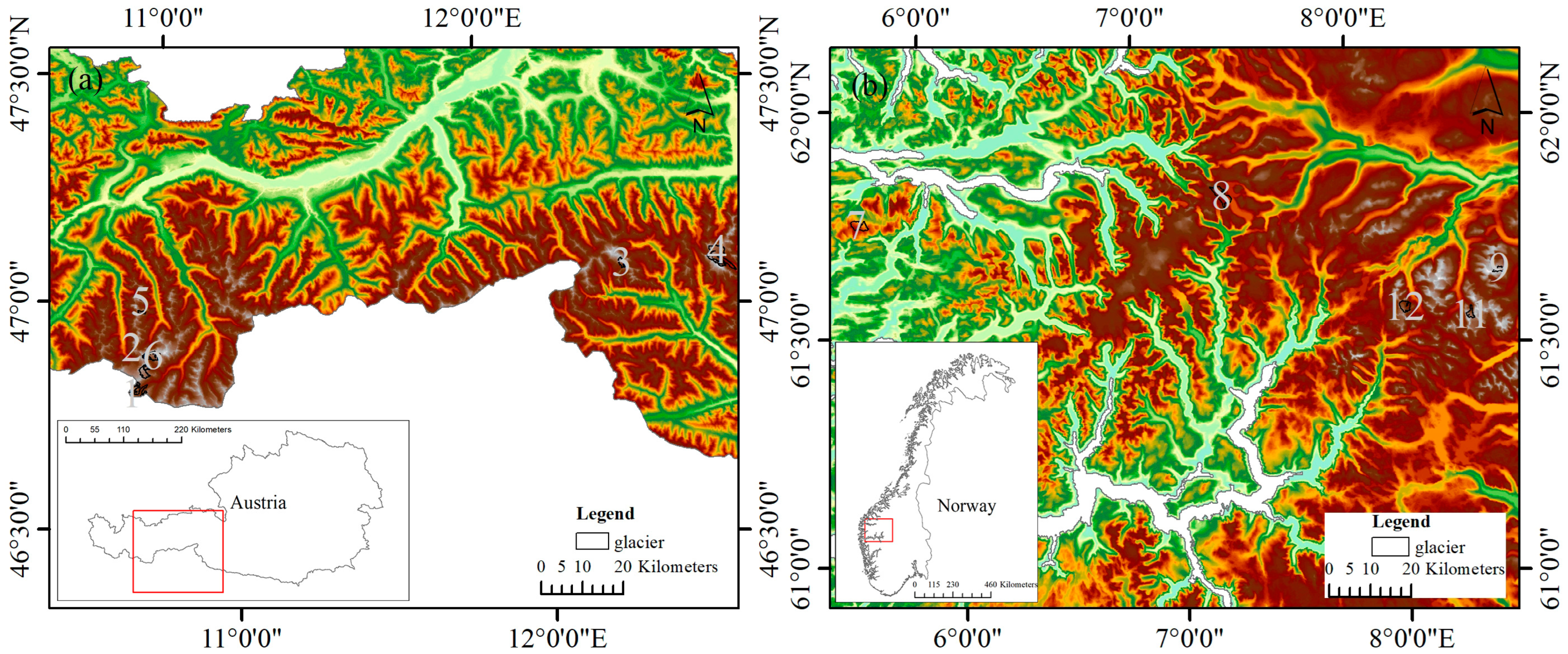
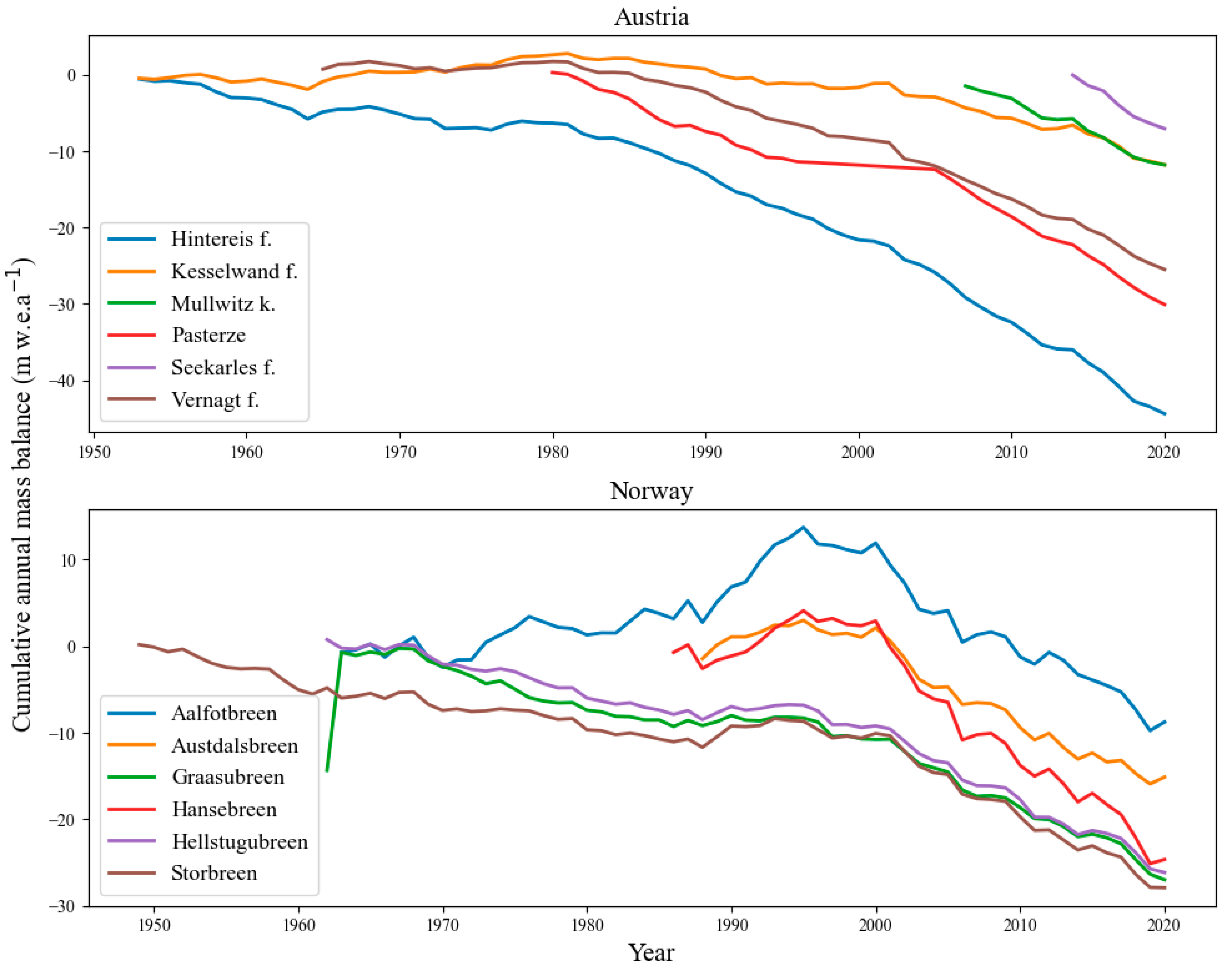
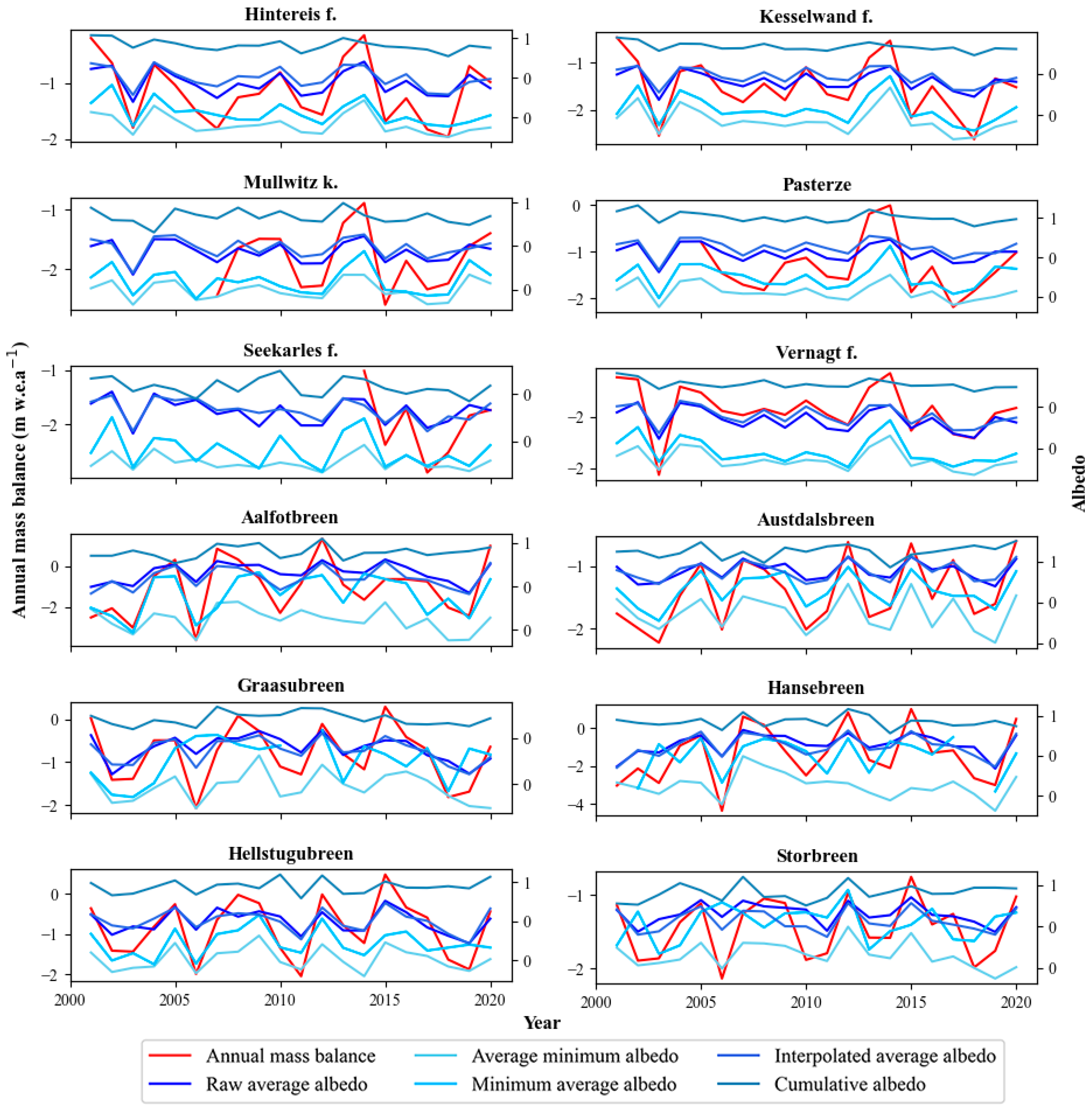
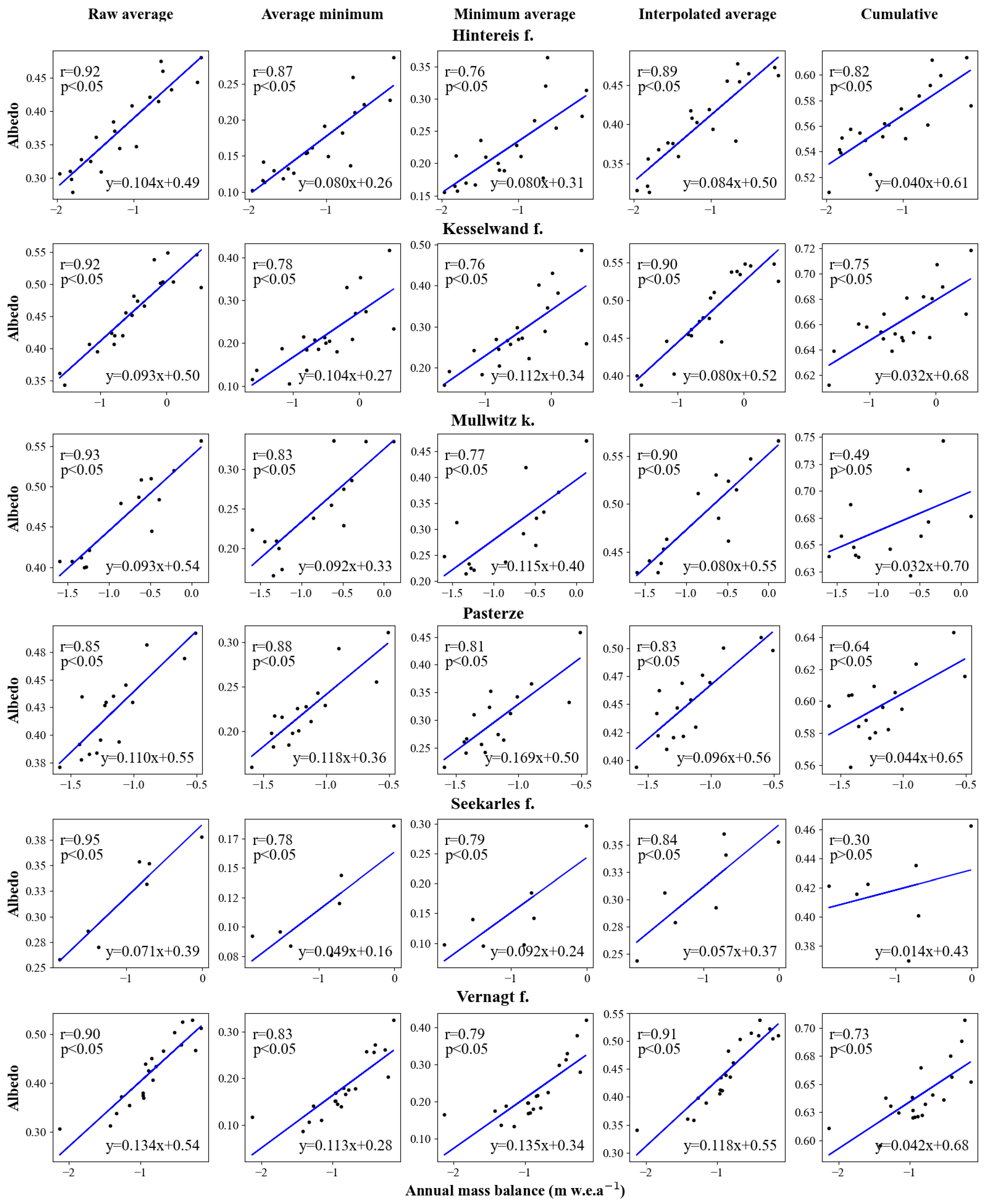


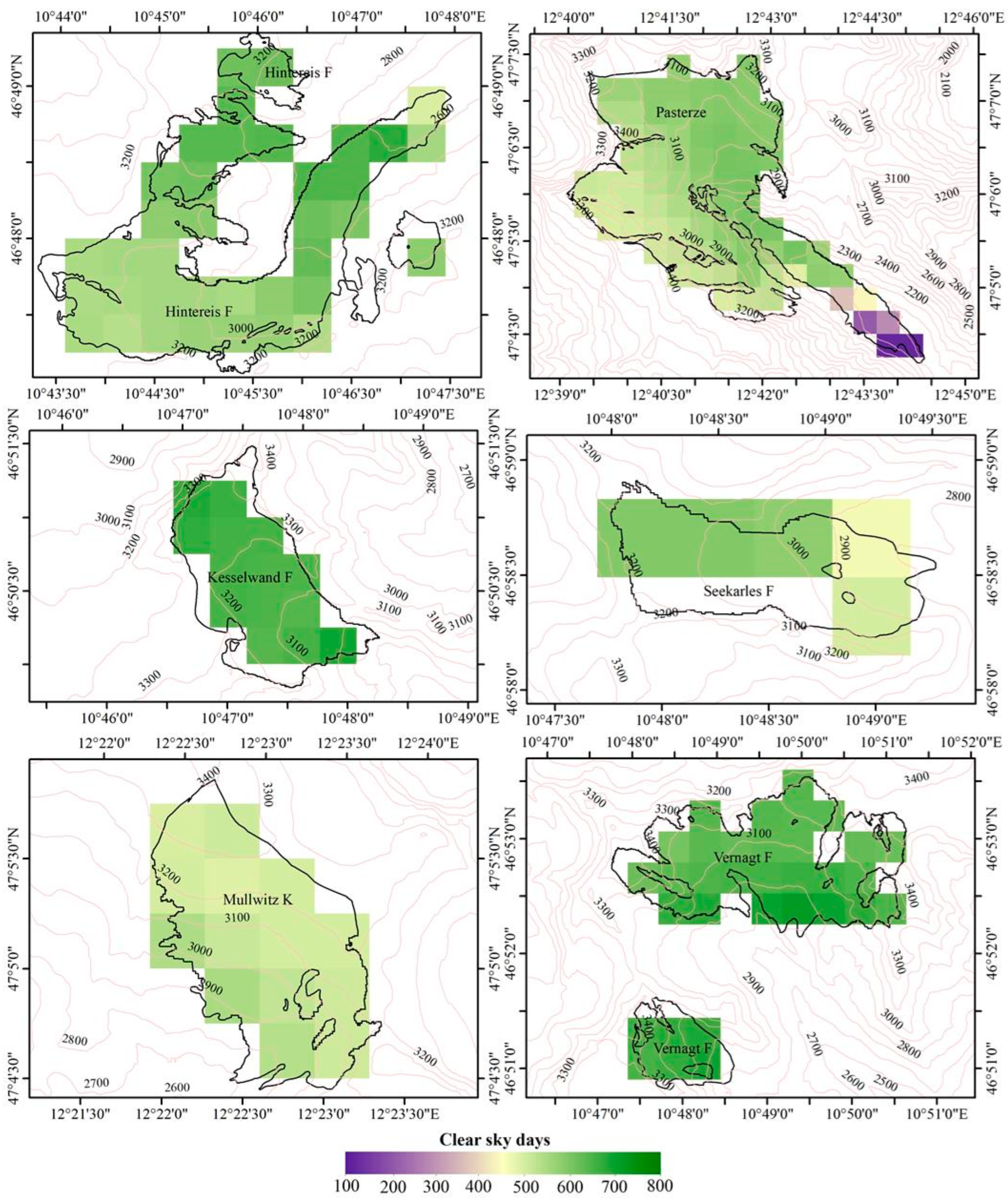
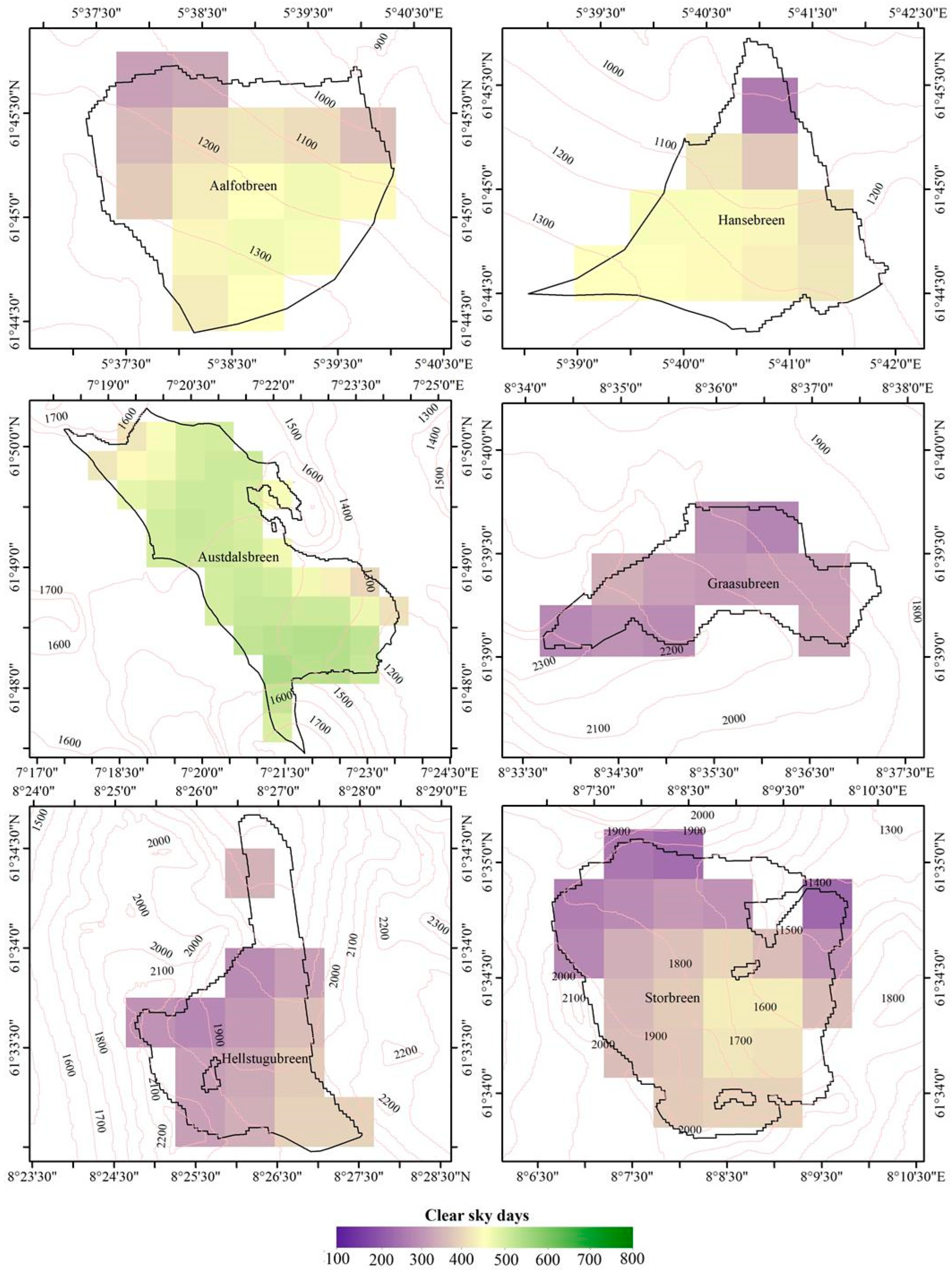

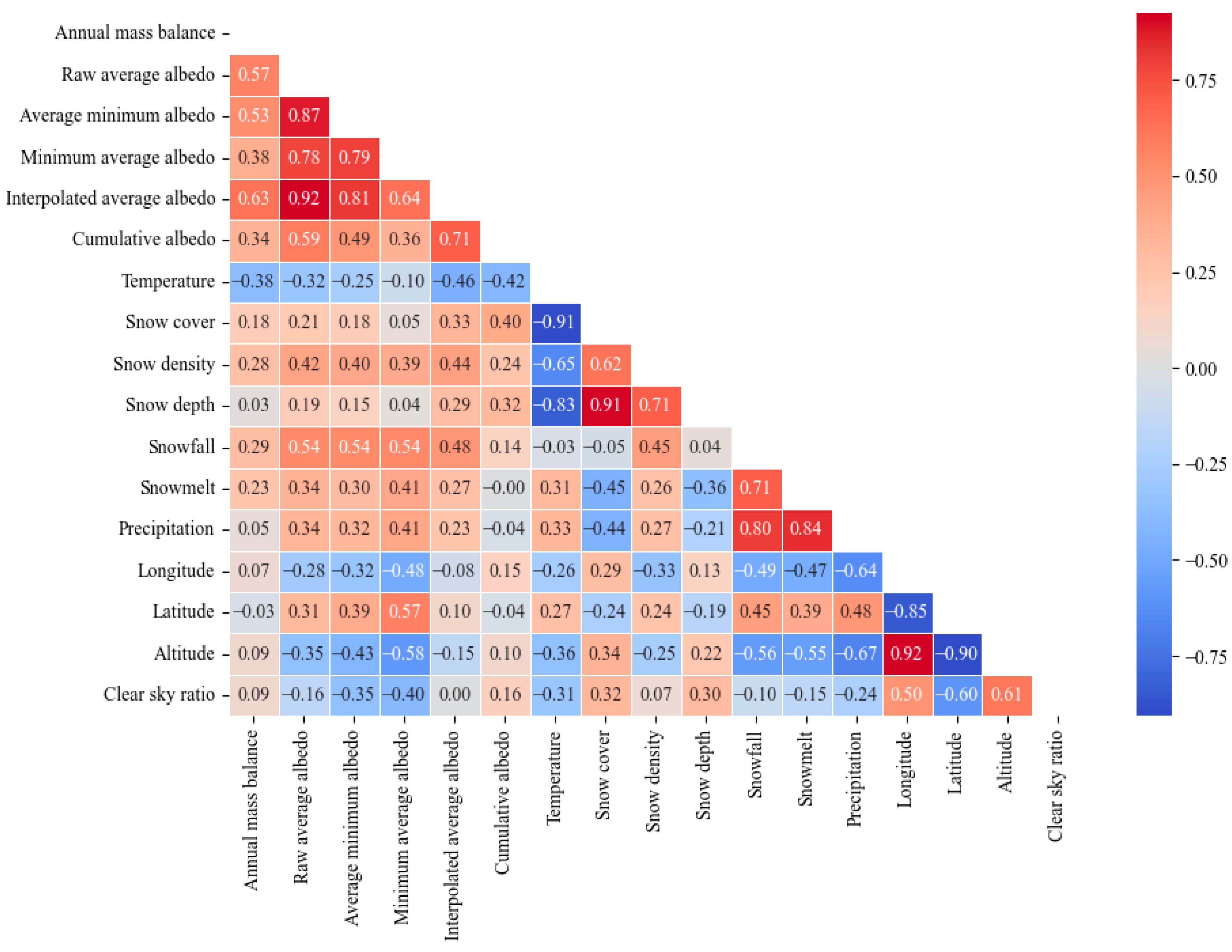
| ID | Name | Country | Lon | Lat | Elevation Range (m) | Area (km2) | Available Time | Glacier Type |
|---|---|---|---|---|---|---|---|---|
| 1 | Hintereis F | Austria | 10.77 | 46.8 | 2547, 3714 | 6.14 | 1953–2020 | continental |
| 2 | Kesselwand F | Austria | 10.79 | 46.84 | 2890, 3497 | 3.55 | 1953–2020 | continental |
| 3 | Mullwitz K | Austria | 12.38 | 47.08 | 2450, 3470 | 2.56 | 2007–2020 | continental |
| 4 | Pasterze | Austria | 12.7 | 47.1 | 2000, 3600 | 15.34 | 1980–2020 | continental |
| 5 | Seekarles F | Austria | 10.82 | 46.98 | 2740, 3255 | 1.04 | 2014–2020 | continental |
| 6 | Vernagt F | Austria | 10.82 | 46.88 | 2872, 3585 | 6.89 | 1965–2020 | continental |
| 7 | Aalfotbreen | Norway | 5.65 | 61.75 | 890, 1368 | 3.48 | 1963–2020 | maritime |
| 8 | Austdalsbreen | Norway | 7.35 | 61.82 | 1200, 1740 | 10.62 | 1988–2020 | maritime-continental |
| 9 | Graasubreen | Norway | 8.6 | 66.66 | 1850, 2277 | 8.05 | 1962–2020 | continental |
| 10 | Hansebreen | Norway | 5.68 | 61.75 | 927, 1310 | 2.48 | 1986–2020 | maritime |
| 11 | Hellstugubreen | Norway | 8.44 | 61.56 | 1487, 2213 | 2.66 | 1962–2020 | continental |
| 12 | Storbreen | Norway | 8.13 | 61.57 | 1420, 2091 | 4.88 | 1949–2020 | maritime-continental |
| Name | Annual Mass Balance (m w.e.a.−1/10 Year) | Raw Average Albedo | ||
|---|---|---|---|---|
| 2001–2010 | 2011–2020 | 2001–2010 | 2011–2020 | |
| Hintereis F | −1.079 | −1.200 | 0.386 | 0.364 |
| Kesselwand F | −0.404 | −0.610 | 0.470 | 0.446 |
| Mullwitz K | −0.767 | −0.872 | 0.477 | 0.459 |
| Pasterze | −1.181 | −1.152 | 0.428 | 0.418 |
| Seekarles F | / | −1.005 | 0.340 | 0.315 |
| Vernagt F | −0.788 | −0.924 | 0.443 | 0.402 |
| Aalfotbreen | −1.313 | −0.753 | 0.460 | 0.466 |
| Austdalsbreen | −1.153 | −0.573 | 0.550 | 0.558 |
| Graasubreen | −0.787 | −0.836 | 0.461 | 0.429 |
| Hansebreen | −1.669 | −1.089 | 0.454 | 0.460 |
| Hellstugubreen | −0.851 | −0.845 | 0.410 | 0.382 |
| Storbreen | −0.964 | −0.822 | 0.470 | 0.453 |
| Name | Country | Raw Average Albedo | Interpolated Average Albedo | ELA | AAR |
|---|---|---|---|---|---|
| Hintereis F | Austria | 0.92 | 0.89 | 0.86 | 0.97 |
| Kesselwand F | Austria | 0.92 | 0.90 | 0.94 | 0.95 |
| Mullwitz K | Austria | 0.93 | 0.90 | 0.79 | 0.76 |
| Pasterze | Austria | 0.85 | 0.83 | 0.59 | 0.87 |
| Seekarles F | Austria | 0.95 | 0.84 | 0.93 | 0.92 |
| Vernagt F | Austria | 0.90 | 0.91 | 0.89 | 0.93 |
| Aalfotbreen | Norway | 0.85 | 0.89 | 0.80 | / |
| Austdalsbreen | Norway | 0.88 | 0.93 | 0.92 | / |
| Graasubreen | Norway | 0.72 | 0.89 | 0.75 | / |
| Hansebreen | Norway | 0.85 | 0.92 | 0.83 | / |
| Hellstugubreen | Norway | 0.83 | 0.91 | 0.95 | / |
| Storbreen | Norway | 0.77 | 0.86 | 0.96 | / |
Disclaimer/Publisher’s Note: The statements, opinions and data contained in all publications are solely those of the individual author(s) and contributor(s) and not of MDPI and/or the editor(s). MDPI and/or the editor(s) disclaim responsibility for any injury to people or property resulting from any ideas, methods, instructions or products referred to in the content. |
© 2024 by the authors. Licensee MDPI, Basel, Switzerland. This article is an open access article distributed under the terms and conditions of the Creative Commons Attribution (CC BY) license (https://creativecommons.org/licenses/by/4.0/).
Share and Cite
Ye, F.; Cheng, Q.; Hao, W.; Hu, A.; Liang, D. Unveiling Glacier Mass Balance: Albedo Aggregation Insights for Austrian and Norwegian Glaciers. Remote Sens. 2024, 16, 1914. https://doi.org/10.3390/rs16111914
Ye F, Cheng Q, Hao W, Hu A, Liang D. Unveiling Glacier Mass Balance: Albedo Aggregation Insights for Austrian and Norwegian Glaciers. Remote Sensing. 2024; 16(11):1914. https://doi.org/10.3390/rs16111914
Chicago/Turabian StyleYe, Fan, Qing Cheng, Weifeng Hao, Anxun Hu, and Dong Liang. 2024. "Unveiling Glacier Mass Balance: Albedo Aggregation Insights for Austrian and Norwegian Glaciers" Remote Sensing 16, no. 11: 1914. https://doi.org/10.3390/rs16111914






